
Everyday companies utilise supply chain technology and software that fall into two distinct categories, those created by a vendor for commercial distribution or those designed and built in house. The former is usually more cost-efficient than the latter but often means a compromise on functionality. Supplain aims to give the user, whether an end-user or a company, the option to choose cost-effective and fit for purpose supply chain integrations using a standardised framework.
Should a company currently wish to purchase third-party software for supply chain management, it must agree to terms and conditions of use, which grant the vendor complete control over the company's data.
That data can often paint a detailed picture of business practices and methodologies and has become a precious resource. These organisations must give this up for free - with no choice but to trust that it won’t be lost, stolen or misused. Progress in open-source blockchain technologies has proven that we can build systems that prioritise individual privacy. These new system protocols are in effect trustless.
Since the beginning of the internet revolution, there has been little innovation in supply chain management; some documentation is still handled on paper, with unlimited potential for mistakes or misuse. The introduction of Web3 technologies has the potential to revolutionise the industry.
Supplain’s vision is to create the open supply chain standard and the infrastructure on which global companies are run, together with industry leaders.
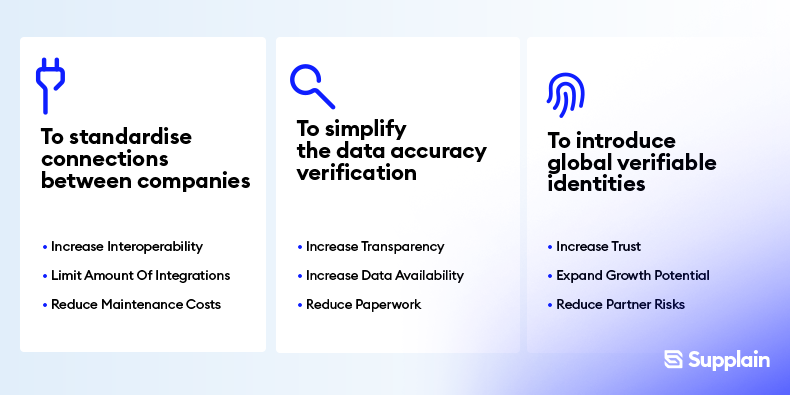
To standardise connections between companies.
(Increasing Interoperability, Limiting the Amount Of Integrations & Lowering Maintenance Costs)
To simplify data accuracy verification.
(Introducing Transparency, Increasing Data Availability & Lowering the Amount of Paperwork)
To introduce verifiable identities.
(Introducing More Trust, Expanding Growth Potential & Lowering Partner Risks)
Our research demonstrates that the entire supply chain is ready to be reimagined.
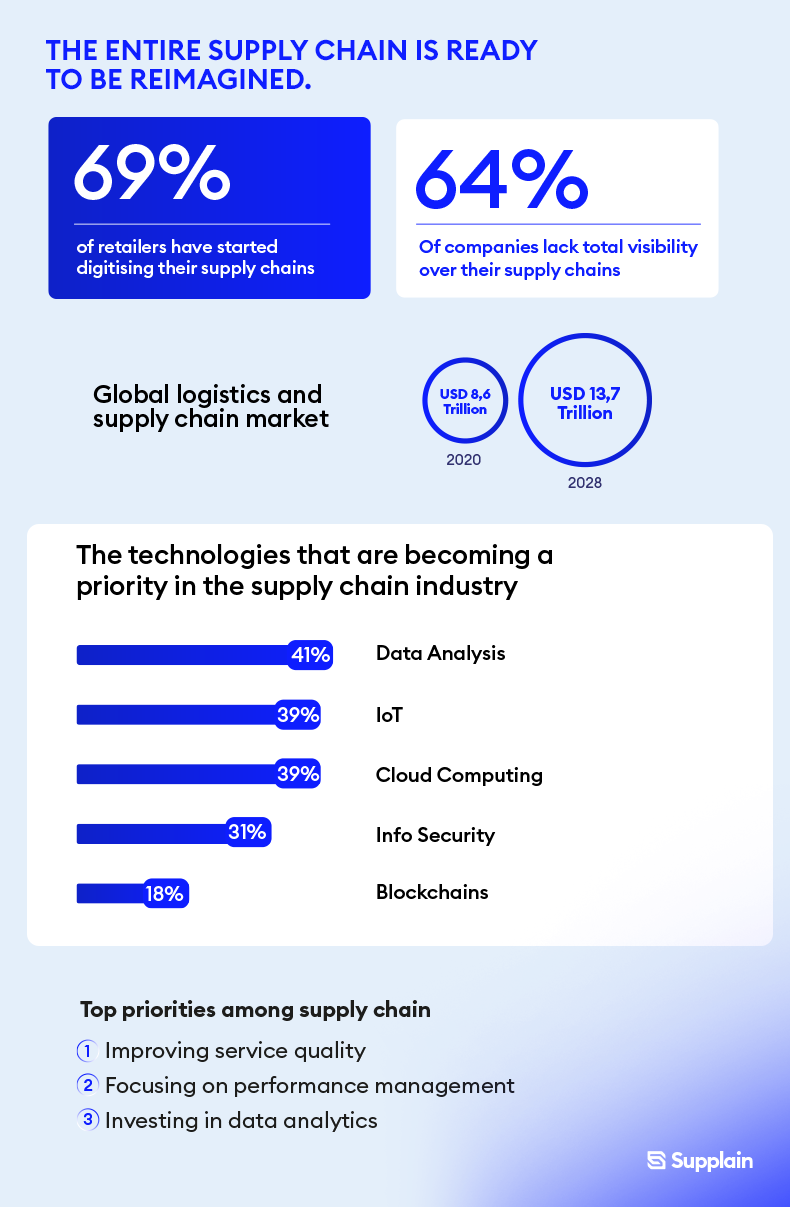
- In 2020, the global logistics and supply chain market was worth almost USD 8.6 Trillion. (Statista) It is expected to reach USD 13.7 Trillion at a steady CAGR of 5.8% by 2028. (Emergen Research)
- The top priorities among supply chain organisations are improving service quality, focusing on performance management, and investing in data analytics. (APQC)
- 69% of companies don’t have total visibility over their supply chains due to a lack of connectivity. (BCI)
- Covid-19 challenged 64% of retailers to start adapting their supply chains for digitisation. (RetailNext)
- The technologies that are becoming a priority in the supply chain industry are data analysis (41%), IoT (39%), cloud computing (39%), info security (31%), and blockchain (18%). (GEODIS)
Encouraging stakeholders to adopt this radical change is a multi-step process. Supplain as a project needs a clear and definitive understanding of the path ahead. In order to achieve this, Supplain will have to create the community, the infrastructure technology, the initial examples of use cases and eventually the new taxonomy required, in partnership with industry leaders.
The Community
The team behind Supplain started the community building process in September 2021 through an NFT project, World of Freight, that has brought together over 1,800 visionary supply chain experts, technologists and investors from diverse backgrounds.
We then hosted the NFT Tallinn event with 500+ attendees to discuss future web3 technology use cases. Next, we’ll host a Supply Chain Innovation Summit to bring together 2,000+ supply chain industry innovators to network and discuss global supply chain problems and potential innovative solutions.
The end goal for these events is to create a consortium of supply chain industry innovators and futurists with whom we can begin creating the taxonomy that the consortium members will adopt as a default.
The Technology
Concerning the open supply chain standard we envisioned, we know that there is a need for updated technologies regardless of what the final taxonomy will cover. Thus, we started building the infrastructure whilst simultaneously creating the consortium.
Four types of electronic data interchange solutions are used to connect supply chain companies. However, all of these have specific limitations:
- Custom integrations and software, aka centralised private solutions. Within these solutions, data is wholly owned by the users and no specific vendor lock-ins, and there is limited data exposure but also limited connectivity between other solutions.
- Third-party solutions, aka centralised public solutions. Within these solutions, there is expanded connectivity, but also the data is owned by solution providers with total vendor lock-in and higher data exposure risk.
- Public blockchain solutions. Within these solutions, data is again owned by the users and no vendor lock-ins, and there is unlimited connectivity, but the data is entirely exposed.
- Private blockchain solutions. Within these solutions, data is still owned by the users, and there is expanded connectivity with limited data exposure, but there is once again a total vendor lock-in.
More specifically, we’re missing solutions where the users would own the data with no vendor lock-ins and where there would be unlimited connectivity with limited data exposure.
At Supplain, we envision building this type of electronic data interchange solution that combines the best parts of existing web2 technologies with innovative web3 mechanics, creating a new open supply chain standard.
As a result, we’re building a privacy-preserving protocol that permits us to introduce information accuracy and identity verification into the data exchange process.
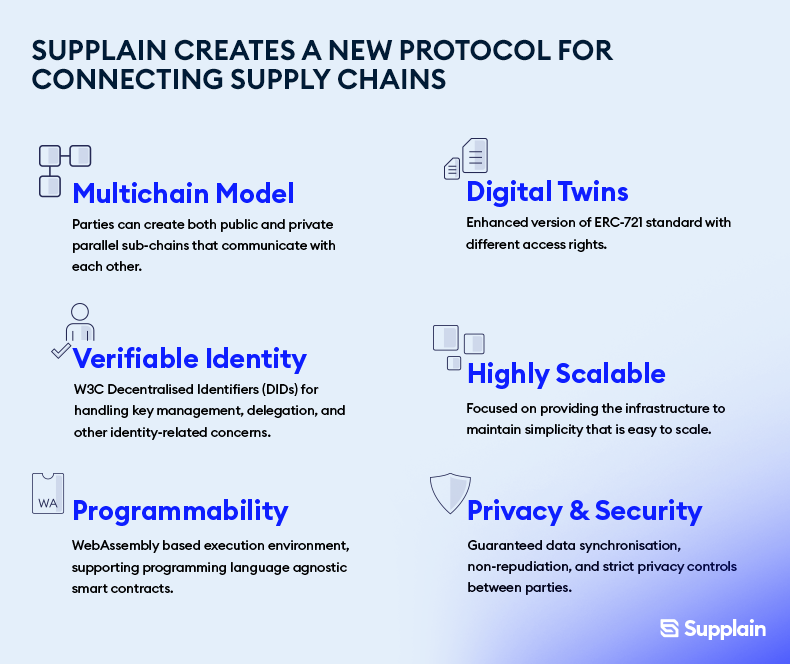
Concerning the technology, this new protocol for connecting supply chains will:
- Utilise a Multichain Model for parties to be able to create both public and private parallel sub-chains that communicate with each other;
- Introduce Digital Twins, an enhanced version of the ERC-721 standard with different access rights;
- Introduce Verifiable Identity tools via the W3C Decentralised Identifiers (DIDs) for handling key management, delegation, and other identity-related concerns.
- Be Highly Scalable, focused on providing the infrastructure to maintain the simplicity that is easy to scale.
- Feature Programmability via WebAssembly based execution environment, supporting programming language agnostic smart contracts.
- And focus on Privacy & Security for guaranteed data synchronisation, non-repudiation, and strict privacy controls between parties.
And within all this, introducing standardised Digital Twins and Verifiable Identity is the key USP. This is mainly due to a lack of information transparency and partner trust being considered the most significant bottleneck for all supply chains. We envision that implementing these two concepts into the new protocol will alleviate or even clear these congestions.
The Use Cases
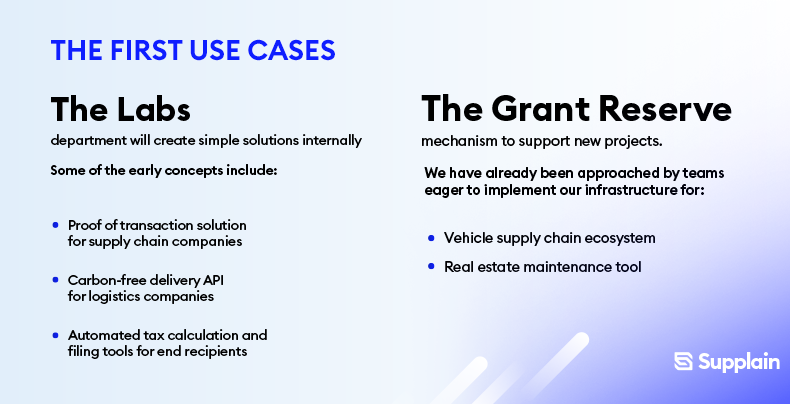
Like with every new technology, there is the question of which will be its first use cases.
We need to demonstrate how combining web2 technologies with web3 mechanics improves service quality, provides more visibility over the supply chains or increases the overall performance for companies taking advantage of these updates.
For that, we will implement two primary processes once the basic protocol launches:
- The Labs department. It is assigned to develop simple yet practical tools that focus on particular concepts utilising Supplain’s protocol.
Some of the early concepts we’ve experimented with include:
- Solutions for supply chain companies getting proof of transaction confirmations.
- APIs for enabling logistics companies to start offering carbon-free deliveries quickly.
- Tools for end recipients to automate Duty and VAT calculations and filing. - The Grant Reserve mechanism will support the creation of new projects utilising Supplain’s protocol.
The first teams are already expressing interest in utilising our infrastructure for;
- Vehicle supply chain ecosystem,
- Real estate maintenance tool.
In addition to these processes, we will explore additional strategic partnerships and implement hackathons and other types of competitions in our events ecosystem.
The Taxonomy
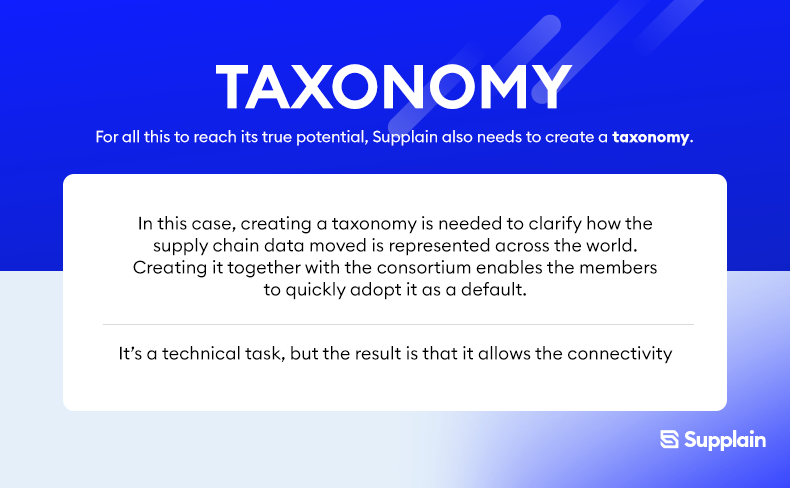
For all this to reach its true potential, Supplain also needs to create a taxonomy.
A taxonomy is required to provide clarity on how the supply chain data moved within the Supplain protocol is represented worldwide. Creating it together with the consortium enables the members to quickly adopt it as a default.
A great analogy, in this case, would be Incoterms. It’s a classic example of taxonomy in the logistics industry that is known and used globally without any confusion. Incoterms are widely-used terms of sale, a set of 11 internationally recognised rules that define the responsibilities of sellers and buyers. Incoterms specify who is responsible for paying for and managing the shipment, insurance, documentation, customs clearance, and other logistical activities.
Everyone is aware of such terminology, there are acronyms, and there’s no language ambiguity. Incoterms are not connected, but they allow insurance, tax, customs, revenue management and other stakeholders to communicate.
Supplain wants to create the taxonomies that immediately identify commonly communicated aspects of the supply chain, including; location, mode of transportation, and tracking of a package beyond one shipment. It’s a technical task, but the result is that it allows the connectivity we’re aiming for.
In 10 years, today’s silos, where all product and transaction information is stored only in private databases and where the connection of which requires significant investments and months of development will be a distant unrecognisable memory, like the telegraph, before the telephone.
Instead, we arrive at a future where compatible concepts and easily connectable databases are used throughout the industry, allowing information to be moved, tracked, and reproduced across the board to allow all of these activities to be identified and verified.
Supplain is a next-generation protocol that aims to unite an entire network of supply chain purpose apps into one verifiable blockchain, thus allowing them to operate seamlessly together at scale. This will require a multifaceted approach, including; technology & software integrations, taxonomy and framework development, in conjunction with industry leaders.
Any supply chain and logistics company in the future can connect to Supplain, unlocking a wide range of real-world supply chain integrations. Supplain is paving the way for new companies to scale their services, gain more transparency, and reduce risks by verifying their identities. The process effectively offers more egalitarian ways to access services through various applications and providers.
Whilst blockchain is demonstrating great promise in several fields — fintech, governance, identity management, cryptocurrency, web decentralisation and asset tracking - as yet, no significant attempts have been made to utilise it for perhaps its most obvious use case: supply chain.
The goal of Supplain is to facilitate global supply chain companies, harmonise the concepts used within the industry into a standardised taxonomy, and create an international data exchange protocol.
This protocol will allow all parties to move supply chain information without relying on companies making direct interfaces with each other. Every interaction will create a reproducible track, and allow transparency between parties.
Supplain's design offers several advantages over existing web2 legacy networks, including scalability, upgradeability and transparent interoperability.
If this is how you see the future and would like to be part of it, contact me directly for further information on potential partnerships or joining us as an investor.
Resources you'll love:
- NFT terms you need to know [Test your NFT vocabulary]
- Top blockchain, crypto and NFT events to flock to in 2022
- Supply chain trends and predictions to look out for in 2022
- The Story Behind World of Freight

![Here are the best NFT games [Updated List]](https://strapi.supplain.io/uploads/What_is_so_special_about_a_World_of_Freight_NFT_and_what_will_move_the_project_forward_b89946b520.png)
